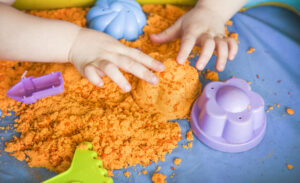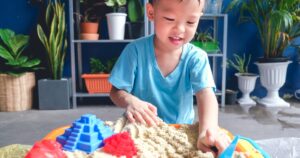Creating a little bit of fun in the form of a sand box, you can work on tactile sensations and emulate the beaches!!
Kitchens ARE where the magic happens! And you don’t need to go buy a big bag of sand to make your indoor sand box, either! By using rice, oats, some food coloring and a bin, you can create granular tactile experiences similar to sand. Grab everything you need. Set out the ingredients. Set out the toys, and put together worlds that the imagination can only create! Kitchen utensils are great for this type of play. Cups, spatulas, bowls or other common objects in your cupboard are great for grabbing, feeling and playing in your homemade sand.
What’s great about indoor sand boxes is that you’re able to work on multiple types of therapies while playing. You can have fun and help your child learn and grow by asking questions, exploring objects, and talking about how things in the sand box feel.
For those with Sensory Processing Disorder (SPD) – a neurological condition in which an individual has difficulty perceiving or responding to any stimuli that affects the senses – new textures can be alarming. A child with SPD can be extremely sensitive to sound, smell, or tactile sensation. Also known as Sensory Integration Dysfunction, this disorder can have a major impact on how a person interacts with everyday objects or surroundings.
BENEFITS
What are the benefits of sensory Bins, like a sensory sand box?
In addition to keeping children entertained and occupied, sensory bins have great developmental benefits:
Provides Outlet for Sensory Exploration
- Objects in sensory bins can easily stimulate multiple senses at a time. For example, a cylinder container filled with dry pasta of various shapes and colors can stimulate your child’s sense of touch, sight, and sound.
Encourages Fine Motor Skills
- Sensory bins can strengthen fingers, wrist motion, and hand arches as children stir, scoop, dig, pour, and shape items.
- Tools like child-friendly tweezers, cups, spoons, and funnels help children develop the grasp and control needed to use writing utensils and self-feeding cutlery.
Fosters Socialization with Peers
- Sensory bins during playtime can build social skills like sharing, taking turns, teamwork, and interpersonal communication.
Encourages Cognitive Development
- Children can use sensory bins to build logic skills like problem solving and sorting different objects by size or color.
- Labeling sensory bin items by number and color can also help with skills like counting and basic arithmetic.
Encourages Language Development
- Labeling items by name can help children quickly identify letters and vocabulary words.
- Talking with your child during interactive sessions can also help build word association and oratory skills.
Provides Opportunities for Children to Calm or Self-Soothe
- Designating sensory bins that contain soft objects can create the perfect activity for children to settle down or play under quiet supervision.
BUILDING YOUR BIN
How to Make Your Own Sensory Bin
There is no one-size-fits-all approach to sensory bins. In fact, child development experts recommend creating themed sensory bins that celebrate different holidays, seasons, or academic subjects. That said, creating a sensory bin does not need to be complicated. The following tips can help you create a basic sensory bin of any material, size, or color theme.
The Three Basic Ingredients
All you need are three basic ingredients to make a great sensory bin. Once you have these items in mind, you can customize them based on size, color, or theme preference:
- Storage Tub (this is the “bin”)
- Sensory Bases (this is the consistent filler for all your child’s “buried treasure”)
- Child-Friendly Tools (jars, measuring cups, funnels, toy dump trucks, plastic Easter eggs)
Storage Tub
The easiest tub is a plastic, under-the-bed storage tub with cover. Medium storage tubs typically work well due to high sides that keep all objects contained. The storage bin can be any child-friendly material. Just make sure it easy to store and can contain objects of various size.
Sensory Base or Filler
The sensory base is the foundation for the rest of the play items. Think of the sensory base like a beach that is perfect for building sandcastles or other activities. For example, a good choice for a base is a collection of assorted pom-pom balls. For safety, try to avoid tiny objects, and always maintain good supervision.
Child-Friendly Toys and Tools
Now the fun begins. Include jars of various size that child can pour and explore. Purchase a plastic measuring-cup set to allow your child to scoop or dig for buried treasure. (As a bonus, measuring cups can also teach your child the basics of size difference, ratio, and proportion.) Tongs and child-friendly scissors help build fine-motor skills. Funnels are always a delightful option, but you can also include toy dump trucks and plastic Easter eggs with fun surprises inside.
Need some inspiration for your sensory bin theme? Here are some favorites from parents around the world:
- Dinosaur sensory bin (complete with plastic dinosaurs, toy shovels, magnifying glasses, and even sand for supervised excavation)
- Autumn sensory bin (great for learning different types of leaves by shape and color)
- Outer space sensory bin (spherical balls of various sizes and colors are the perfect representation for planets across our solar system)
- Holiday sensory bin (Halloween, Christmas, Valentine’s Day, and Easter are memorable options)
- Stuffed animal safari sensory bin
- Lego world sensory bin
If you believe your child needs extra help with sensory management, The Warren Center is here for you. We offer a range of therapy and support services for a child’s individual needs. For more information, contact us.




